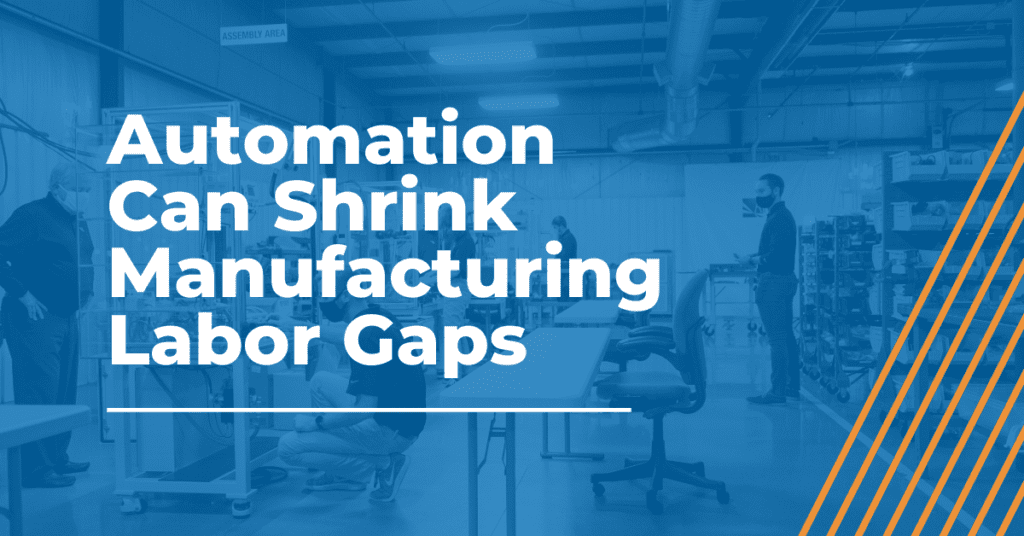
Manufacturing Labor Shortage: Three Ways to Identify Areas to Automate
In today’s economy, American industrial manufacturing is at a pivotal crossroads. Consumer demand for manufactured products has increased steadily over the past 10 years, yet the manufacturing labor shortage has also increased over that same time. We have more things to make, and fewer people available or interested in making them.
To some, this manufacturing labor shortage is a self-fulfilling prophecy, with fewer available opportunities presenting the appearance of job insecurity, dissuading new workers from joining the ranks. To others, the trend is simply the result of gains in productivity.
This labor shortage trend is clearly set to continue, so how can manufacturers cope? One option is to assess your production line for places to automate. That is, to migrate a task from human labor to intelligent machinery. Identifying what tasks are good candidates for replacement with automation can be tricky, and sometimes met with a negative impression of “looking for people to fire.” We see automation placement as wholly positive, both for the business and the people involved. In this spirit, here we describe three ways to identify automation opportunities in your production line.
Opportunity to Train Up
The US Bureau of Labor Statistics groups manufacturing workers into five categories, seen in the chart below. We can see that team assemblers (those who perform a portion of the overall task of building the part” is by far the largest employee group. Your manufacturing plant likely follows this same concentration of job types, so let’s start there.
| Data series | Employment, 2019 |
| Helpers–production workers | 186,280 |
| Inspectors, testers, sorters, samplers, and weighers | 365,290 |
| Machinists | 316,630 |
| Purchasing agents, except wholesale, retail, and farm products | 100,630 |
| Team assemblers | 1,006,910 |
Assembly jobs are often some of the easiest to examine for automation benefits. Work tasks that are highly repetitive, cyclic and invariable in nature are ripe for fulfilling with an automated solution in place of human labor. Placing caps on bottles, applying labels to boxes and affixing stickers to electronics are just three examples of this type of task. Deterministic machinery can be built, installed and operated to perform the same tasks. These automated solutions can even be coupled together to perform highly complex assemblies, scaling to help save as few or as many human positions as your company needs.
To us, we consider this an opportunity to train the displaced employees up, not necessarily to replace them. Assembly workers can be considered for moving into tangential roles in other departments or be trained as equipment operators, for example. Best yet, these employees are good options for filling other positions in the business, reducing the need to scour for new hires.
Opportunity to Bolster Control Metrics
Critical control points are those stages in a manufacturing sequence where any abnormalities in the product are identified and rejected. Think of placing the safety seal on a bottle of orange juice, confirming the right medication is in a bottle or measuring the thickness of a car tire mold. Any deviation from manufacturing specifications fails the part, which then has to be remade in order to be acceptable.
Many companies still use human inspectors and testers to manage their control points. While this is great in areas that require human judgement, there are other areas that could easily be automated with programmatic rules and instrumentation. More so, when the control point job consists of mundane measurement or actions – imagine looking at pills to assure the medication logo is stamped properly for eight hours a day – a human is prone to making mistakes. Automation can allow for higher accuracy, fewer errors and indefinite operating times.
An alternative here would be a vision reject system: a scanning instrument that captures an image of each pill that passes on a conveyor line, compares the image to a specified standard image of how the pill should look and automatically decides to pass the pill forward or reject it to waste. These sorts of opportunities reduce the need for a human while simultaneously improving overall performance of your critical control points.
Opportunity to Heighten Safety
An idea that not many manufacturing leaders think of when considering automation opportunities, is to have a chat with their environmental health and safety manager first. Your EHS team deals with risk, hygiene, injuries and compliance all day. These team members can offer unique insight into where removing humans from risk points will benefit everyone. The solution, oftentimes, can be automation.
Applying hot adhesive, stacking heavy cartons, checking the temperature of a hot cook tank, applying chemical finishes to metal parts – all of these are examples of risky tasks that could be more safely done with automated machinery. Glue applicators, cartoner sorters, temperature transmitters and spray coaters are automated systems that could be installed to take the human out of harm’s way. With this approach, you’re evaluating your production line for opportunities to showcase your commitment to health and safety, while simultaneously reducing staffing strains presented by today’s manufacturing labor shortage.
Coping with the Manufacturing Labor Shortage
For more than 20 years, AMS has been helping manufacturers support their employees and deliver the best products possible. If you have questions about automating your operations, let’s talk.
Our Automated Medical Manufacturing White Paper Will Help You Envision New Ways of Operating
Reading this white paper will help you:
